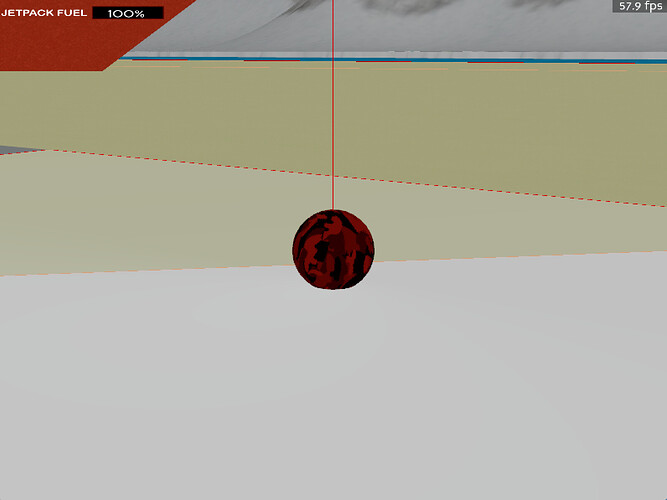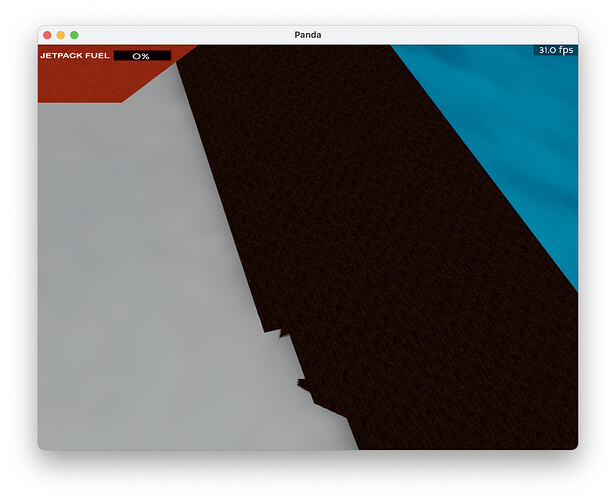Yes, playerholder is the parent of the player model, the collision and a bunch of other nodes (mainly for the camera control, so if I move the camera it doesn’t rotate the player model).
Here is the full code for player.py:
import sys
from panda3d.core import Vec3,PointLight, WindowProperties, CollisionTraverser, CollisionHandlerPusher, CollisionSphere, CollisionNode, CollideMask, BitMask32
import math
from playerGUI import GUI
class Player():
def __init__(self,camera,accept,render,loader,maxJPHeight):
#initial variables and sounds
self.jetPack_energy = 100
self.maximumHeight = maxJPHeight
self.jetPack_AUDIO = loader.loadSfx("assets/base/sounds/jetpack2.wav")
self.jetPack_AUDIO.setLoop(True)
#initiate GUI
self.HUD = GUI()
self.playerHolder = render.attachNewNode('player')
self.character = loader.loadModel('assets/base/models/player.bam')
self.toggleFPCam = False
self.character.setPos(0,0,0)
self.character.reparentTo(self.playerHolder)
self.playerBase = self.playerHolder.attachNewNode('camParent')
self.thirdPersonNode = self.playerBase.attachNewNode('thirdPersonCam')
camera.reparentTo(self.thirdPersonNode)
self.mouseSeconds = []
#collision stuff
self.pusher = CollisionHandlerPusher()
self.colliderNode = CollisionNode("player")
self.colliderNode.addSolid(CollisionSphere(0, 0, 0, 1))
self.colliderNode.setFromCollideMask(CollideMask.bit(0))
self.colliderNode.setIntoCollideMask(BitMask32.allOff())
collider = self.playerHolder.attachNewNode(self.colliderNode)
self.pusher.addCollider(collider,self.playerHolder)
self.cTrav = CollisionTraverser()
self.cTrav.addCollider(collider,self.pusher)
self.cTrav.show_collisions(render)
self.setupLighting() # light
#initial position
self.playerHolder.setPos(64529.7, 25629.3, 2000)
self.keyMap = {
"left": False,
"right": False,
"forward": False,
"backwards": False,
"change_camera": False,
"leftClick": False,
"space": False,
"p":False
}
accept("escape", sys.exit)
accept("w", self.updateKey, ["forward", True]) #
accept("w-up", self.updateKey, ["forward", False])
accept("a", self.updateKey, ["left", True])
accept("a-up", self.updateKey, ["left", False])
accept("s", self.updateKey, ["backwards", True])
accept("s-up", self.updateKey, ["backwards", False])
accept("d", self.updateKey, ["right", True])
accept("d-up", self.updateKey, ["right", False])
accept("c",self.updateKey,["change_camera", True])
accept("mouse1",self.updateKey,["leftClick",True])
accept("mouse1-up",self.updateKey,["leftClick",False])
accept("p", self.updateKey, ["p", True])
accept("p-up", self.updateKey, ["p", False])
accept("space",self.updateKey,["space",True])
accept("space-up",self.updateKey,["space",False])
def updateKey(self,key,value):
self.keyMap[key] = value
if key == "change_camera":
self.changeCamera()
def changeCamera(self):
if self.toggleFPCam == False:
self.toggleFPCam = True
else:
self.toggleFPCam = False
def recenterMouse(self):
base.win.movePointer(0, int(base.win.getProperties().getXSize() / 2), int(base.win.getProperties().getYSize() / 2))
def setupLighting(self):
plight = PointLight('plight')
plight.setColor((0.2, 0.2, 0.2, 1))
plnp = self.playerHolder.attachNewNode(plight)
render.setLight(plnp)
def playerUpdate(self,task):
deltaTime = globalClock.getDt()
#mouse controls
if self.toggleFPCam: #first person camera controls
camera.setPos(self.character.getPos()) # 0,-50,-10
#camera.setZ(camera, 20)
props = WindowProperties()
props.setCursorHidden(True)
props.setMouseMode(WindowProperties.M_relative)
base.win.requestProperties(props)
self.character.hide()
if (base.mouseWatcherNode.hasMouse() == True):
mouseposition = base.mouseWatcherNode.getMouse()
camera.setP(mouseposition.getY() * 30)
#self.playerBase.setH(self.playerBase.getH())
#camera.setP(mouseposition.getY() * 30)
self.playerBase.setH(mouseposition.getX() * -50)
if (mouseposition.getX() < 0.1 and mouseposition.getX() > -0.1):
self.playerBase.setH(self.playerBase.getH())
else:
#self.playerBase.setH(self.playerBase.getH() + mouseposition.getX() * -1)
pass
else: #takes out of first person perspective if toggleFPS is turned off.
props = WindowProperties()
props.setCursorHidden(False)
props.setMouseMode(WindowProperties.M_absolute)
base.win.requestProperties(props)
self.character.show()
camera.setPos(0, -50, -4) # 0,-50,-10
camera.lookAt(self.character)
self.walkConstant = 900
self.rotateConstant = 100
#Keyboard controls
if self.keyMap["forward"]:
self.playerHolder.setY(self.playerBase, (self.walkConstant*deltaTime))
self.character.setP(self.character.getP() + (-self.rotateConstant*deltaTime*(math.cos(math.radians(self.playerBase.getH())))))
self.character.setR(self.character.getR() - (self.rotateConstant*deltaTime*(-math.sin(math.radians(self.playerBase.getH())))))
if self.keyMap["right"]:
self.playerHolder.setX(self.playerBase, (self.walkConstant*deltaTime))
if self.keyMap["p"]:
print(self.playerHolder.getPos())
if self.keyMap["left"]:
self.playerHolder.setX(self.playerBase, (-self.walkConstant*deltaTime))
if self.keyMap["backwards"]:
self.playerHolder.setY(self.playerBase, (-self.walkConstant * deltaTime))
self.character.setP(self.character,(self.rotateConstant*deltaTime))
if self.keyMap["space"] and self.jetPack_energy>0:
jetpack = 0.00001*(((self.playerHolder.getZ())-self.maximumHeight)**2)+98.1
self.playerHolder.setZ(self.playerBase, jetpack)
self.jetPack_energy -= 8*deltaTime
if self.jetPack_AUDIO.status() != self.jetPack_AUDIO.PLAYING:
self.jetPack_AUDIO.play()
else:
if self.jetPack_energy < 100:
self.jetPack_energy += 10*deltaTime
if self.jetPack_energy > 100:
self.jetPack_energy = 100
self.jetPack_AUDIO.stop()
self.HUD.jetpackStatus.text = str(int(self.jetPack_energy))+"%"
#third person camera control
if (self.keyMap["leftClick"] == True) and (self.toggleFPCam == False): #third person camera controls
if (base.mouseWatcherNode.hasMouse() == True):
mouseposition = base.mouseWatcherNode.getMouse()
self.mouseSeconds.append(mouseposition)
if len(self.mouseSeconds) == 2:
lookConstant = 1
upperconstant = 40
lowerconstant = 1
moveX = ((self.mouseSeconds[1].getX())*upperconstant - (self.mouseSeconds[0].getX())*lowerconstant)*lookConstant
moveY = ((self.mouseSeconds[1].getY())*upperconstant - (self.mouseSeconds[0].getY())*lowerconstant)*lookConstant
if (moveX > 1 or moveX < -1):
self.playerBase.setH(self.playerBase.getH() - moveX)
if (moveY > 1 or moveY < -1):
self.thirdPersonNode.setP(self.thirdPersonNode.getY()+moveY)
self.mouseSeconds = []
self.cTrav.traverse(render)
self.playerHolder.setPos(self.playerHolder, Vec3(0,0,-98.1)) # Gravity
return task.cont




